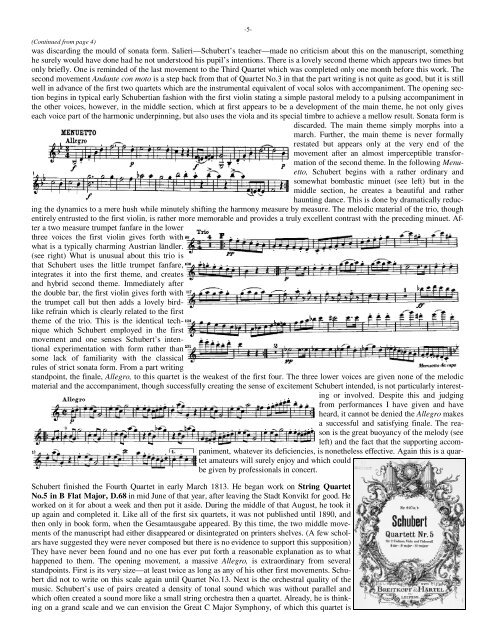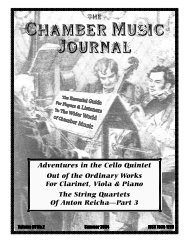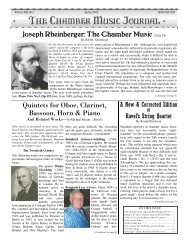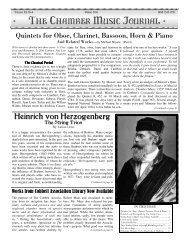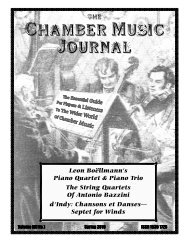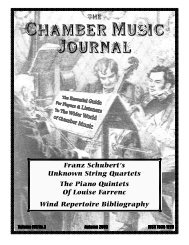Volume 14 No.4 - Cobbett Association
Volume 14 No.4 - Cobbett Association
Volume 14 No.4 - Cobbett Association
You also want an ePaper? Increase the reach of your titles
YUMPU automatically turns print PDFs into web optimized ePapers that Google loves.
-5-<br />
(Continued from page 4)<br />
was discarding the mould of sonata form. Salieri—Schubert’s teacher—made no criticism about this on the manuscript, something<br />
he surely would have done had he not understood his pupil’s intentions. There is a lovely second theme which appears two times but<br />
only briefly. One is reminded of the last movement to the Third Quartet which was completed only one month before this work. The<br />
second movement Andante con moto is a step back from that of Quartet No.3 in that the part writing is not quite as good, but it is still<br />
well in advance of the first two quartets which are the instrumental equivalent of vocal solos with accompaniment. The opening section<br />
begins in typical early Schubertian fashion with the first violin stating a simple pastoral melody to a pulsing accompaniment in<br />
the other voices, however, in the middle section, which at first appears to be a development of the main theme, he not only gives<br />
each voice part of the harmonic underpinning, but also uses the viola and its special timbre to achieve a mellow result. Sonata form is<br />
discarded. The main theme simply morphs into a<br />
march. Further, the main theme is never formally<br />
restated but appears only at the very end of the<br />
movement after an almost imperceptible transformation<br />
of the second theme. In the following Menuetto,<br />
Schubert begins with a rather ordinary and<br />
somewhat bombastic minuet (see left) but in the<br />
middle section, he creates a beautiful and rather<br />
haunting dance. This is done by dramatically reducing<br />
the dynamics to a mere hush while minutely shifting the harmony measure by measure. The melodic material of the trio, though<br />
entirely entrusted to the first violin, is rather more memorable and provides a truly excellent contrast with the preceding minuet. After<br />
a two measure trumpet fanfare in the lower<br />
three voices the first violin gives forth with<br />
what is a typically charming Austrian ländler.<br />
(see right) What is unusual about this trio is<br />
that Schubert uses the little trumpet fanfare,<br />
integrates it into the first theme, and creates<br />
and hybrid second theme. Immediately after<br />
the double bar, the first violin gives forth with<br />
the trumpet call but then adds a lovely birdlike<br />
refrain which is clearly related to the first<br />
theme of the trio. This is the identical technique<br />
which Schubert employed in the first<br />
movement and one senses Schubert’s intentional<br />
experimentation with form rather than<br />
some lack of familiarity with the classical<br />
rules of strict sonata form. From a part writing<br />
standpoint, the finale, Allegro, to this quartet is the weakest of the first four. The three lower voices are given none of the melodic<br />
material and the accompaniment, though successfully creating the sense of excitement Schubert intended, is not particularly interesting<br />
or involved. Despite this and judging<br />
from performances I have given and have<br />
heard, it cannot be denied the Allegro makes<br />
a successful and satisfying finale. The reason<br />
is the great buoyancy of the melody (see<br />
left) and the fact that the supporting accompaniment,<br />
whatever its deficiencies, is nonetheless effective. Again this is a quartet<br />
amateurs will surely enjoy and which could<br />
be given by professionals in concert.<br />
Schubert finished the Fourth Quartet in early March 1813. He began work on String Quartet<br />
No.5 in B Flat Major, D.68 in mid June of that year, after leaving the Stadt Konvikt for good. He<br />
worked on it for about a week and then put it aside. During the middle of that August, he took it<br />
up again and completed it. Like all of the first six quartets, it was not published until 1890, and<br />
then only in book form, when the Gesamtausgabe appeared. By this time, the two middle movements<br />
of the manuscript had either disappeared or disintegrated on printers shelves. (A few scholars<br />
have suggested they were never composed but there is no evidence to support this supposition)<br />
They have never been found and no one has ever put forth a reasonable explanation as to what<br />
happened to them. The opening movement, a massive Allegro, is extraordinary from several<br />
standpoints. First is its very size—at least twice as long as any of his other first movements. Schubert<br />
did not to write on this scale again until Quartet No.13. Next is the orchestral quality of the<br />
music. Schubert’s use of pairs created a density of tonal sound which was without parallel and<br />
which often created a sound more like a small string orchestra then a quartet. Already, he is thinking<br />
on a grand scale and we can envision the Great C Major Symphony, of which this quartet is


